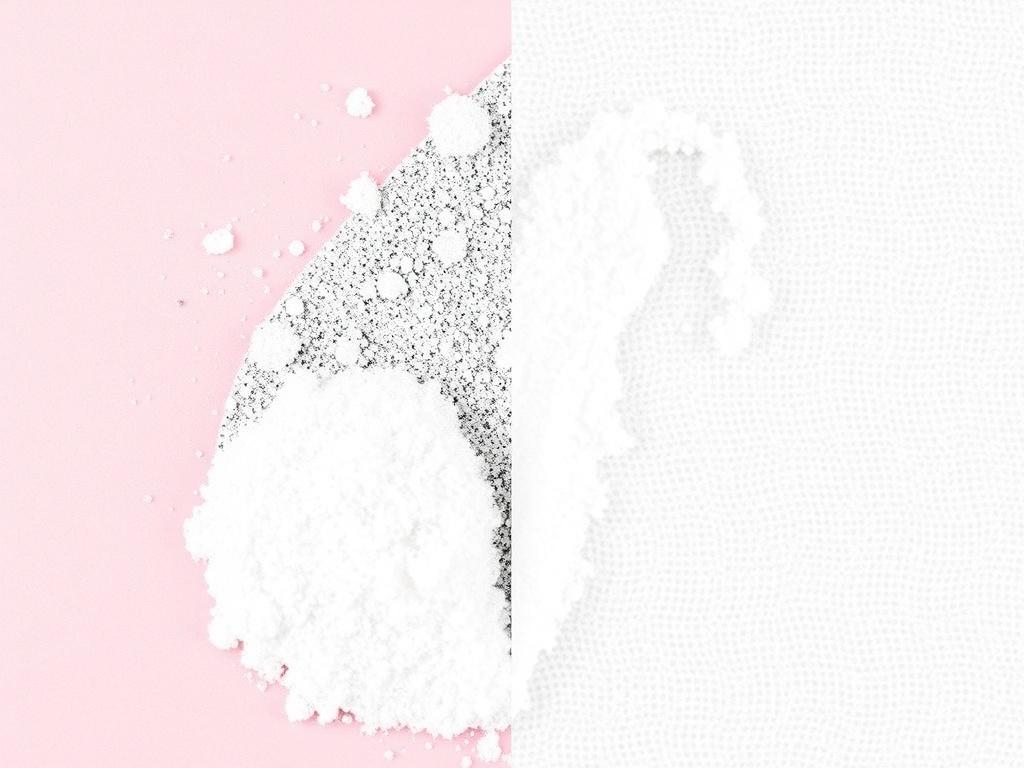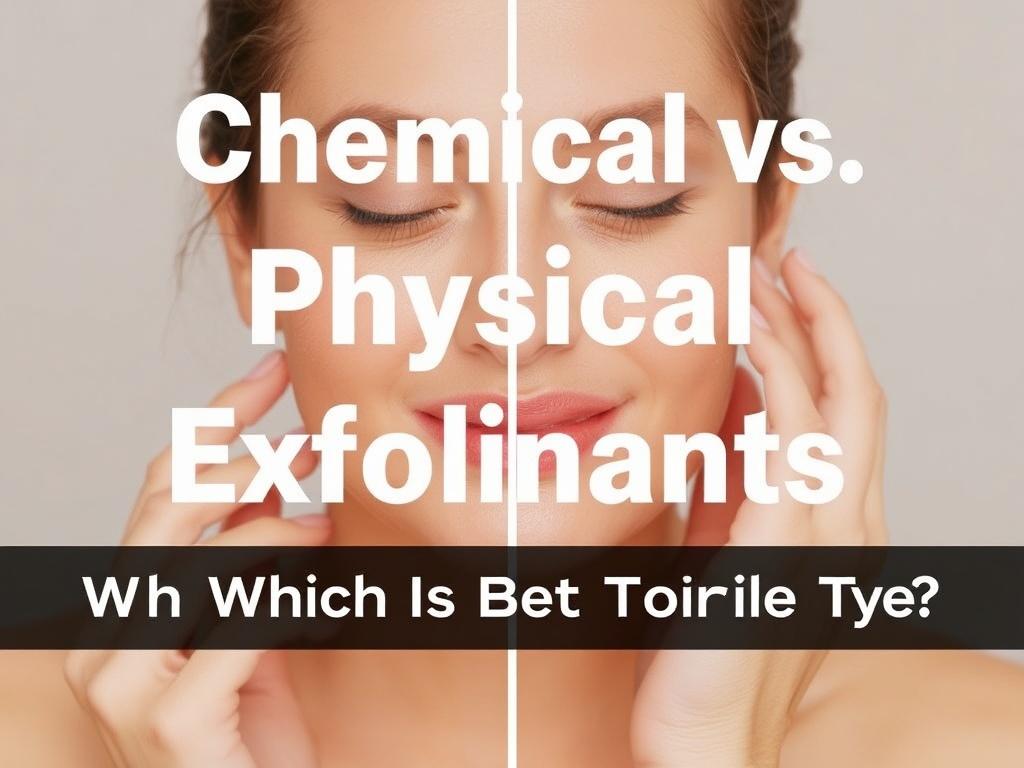Содержание статьи
- 1 What Are Physical Exfoliants?
- 2 What Are Chemical Exfoliants?
- 3 Comparing Chemical vs. Physical Exfoliants
- 4 Which Exfoliant Is Better for Your Skin Type?
- 5 How to Use Chemical and Physical Exfoliants Safely
- 6 Popular Ingredients in Chemical Exfoliants and Their Uses
- 7 Environmental and Ethical Considerations
- 8 DIY Exfoliants: Should You Try Them?
- 9 Summary: Chemical vs. Physical Exfoliants
- 10 Conclusion
Exfoliation has become a cornerstone of modern skincare routines. Whether you’re trying to brighten your complexion, smooth rough patches, or simply maintain a fresh, healthy glow, exfoliating regularly can work wonders. But with so many products on the market, the big question remains: Chemical vs. physical exfoliants, which is better? This article dives deep into these two types of exfoliation, explaining how they work, their benefits and drawbacks, and how to decide what’s best for your unique skin type.
Let’s start with the basics. Exfoliation is the process of removing dead skin cells from the surface of your skin. Your body is constantly renewing its skin cells, but sometimes dead cells build up, clogging pores and leaving skin looking dull, rough, or prone to breakouts. By exfoliating, you help accelerate the shedding of this dead skin layer, revealing fresher, more vibrant skin underneath.
What Are Physical Exfoliants?

Physical exfoliants, also called mechanical exfoliants, rely on manual scrubbing action to remove dead skin. These can be in the form of scrubs, brushes, sponges, or cloths that you rub against your skin to physically slough off dry, flaky cells. Think of products with tiny grains like sugar, salt, or jojoba beads designed to buff your skin’s surface.
Many people enjoy physical exfoliation because it offers immediate feedback—you can feel the scrubbing and see dead skin washing off. However, it’s important to be gentle as overdoing it or using harsh scrubs can cause microtears or irritation.
Common Types of Physical Exfoliants
- Facial scrubs with exfoliating beads or grains
- Konjac sponges
- Loofahs or washcloths
- Exfoliating brushes or silicone cleansing tools
Physical exfoliation is straightforward but demands care—scrubbing too hard or using rough particles can damage the skin.
What Are Chemical Exfoliants?
Chemical exfoliants use ingredients that dissolve dead skin cells and loosen their grip on the surface of your skin without any scrubbing. These active ingredients penetrate the skin and encourage cells to shed naturally, promoting fresh cell turnover underneath.
The two most popular types of chemical exfoliants are alpha hydroxy acids (AHAs) and beta hydroxy acids (BHAs). AHAs such as glycolic acid and lactic acid are water-soluble and great for improving skin texture and brightening. BHAs, like salicylic acid, are oil-soluble, which makes them excellent for penetrating into clogged pores and treating acne-prone skin.
Key Chemical Exfoliants and Their Benefits
| Exfoliant Type | Example Ingredients | Skin Type Best For | Primary Benefits |
|---|---|---|---|
| Alpha Hydroxy Acids (AHAs) | Glycolic acid, Lactic acid, Mandelic acid | Dry, dull, sun-damaged skin | Brightening, smooths texture, hydrates |
| Beta Hydroxy Acids (BHAs) | Salicylic acid | Oily, acne-prone skin | Deep pore cleansing, reduces breakouts |
| Polyhydroxy Acids (PHAs) | Gluconolactone, Lactobionic acid | Sensitive skin | Gentle exfoliation, hydrates, antioxidant |
Chemical exfoliants often deliver longer-lasting results because they work beneath the surface at a cellular level, rather than just scrubbing away the top layers.
Comparing Chemical vs. Physical Exfoliants
When choosing between chemical and physical exfoliants, it’s important to consider your skin type, concerns, and personal preferences. Here’s a side-by-side comparison to help you weigh the pros and cons:
| Feature | Chemical Exfoliants | Physical Exfoliants |
|---|---|---|
| How They Work | Dissolve dead cells using acids | Scrub off dead skin manually |
| Effectiveness | More even exfoliation, deep action | Immediate exfoliation on surface |
| Suitability for Sensitive Skin | Gentle chemical exfoliants available | Can cause irritation if scrub is harsh |
| Risk of Irritation | May cause redness, especially if overused | Risk of micro-tears and abrasion |
| Frequency of Use | Usually 1-3 times per week | 1-2 times per week recommended |
| Results Timeline | Visible over days with regular use | Immediate but often short-lived |
As you can see, chemical exfoliants often offer a more controlled and predictable way to remove dead skin, but physical exfoliants provide instant gratification. Your choice depends on what fits your lifestyle and skin’s needs best.
Which Exfoliant Is Better for Your Skin Type?

Choosing between chemical vs. physical exfoliants largely depends on your skin type and concerns. Here’s a breakdown to guide you through which type may work best.
For Oily and Acne-Prone Skin
If you battle acne and excess oil, chemical exfoliants with salicylic acid (a BHA) are often the best bet. Salicylic acid penetrates oily pores and gently clears blockages, preventing blackheads and breakouts. Physical scrubs can sometimes exacerbate inflammation and introduce irritation, making them less ideal for sensitive acne-prone skin.
For Dry or Sun-Damaged Skin
Dry or dull skin benefits from AHAs such as glycolic and lactic acid, which gently exfoliate while also promoting moisture retention and brightening. Physical exfoliants might be too abrasive and can strip already dry skin of precious moisture, so chemical exfoliants generally offer more nourishment.
For Sensitive Skin
Sensitive skin demands extra caution. Physical exfoliation can quickly cause irritation, redness, or micro-tears. Chemical exfoliants classified as PHAs, like gluconolactone, offer gentler peeling action with added hydration and antioxidant properties. They’re often better tolerated and less likely to cause inflammation.
For Normal or Combination Skin
If your skin is balanced, you have more flexibility. Some prefer physical exfoliants for the tactile experience and fresh feeling, while others enjoy the gradual improvements from chemical exfoliants. In fact, many people combine both types in their routine, using physical exfoliation once a week and chemical exfoliation a couple of times per week.
How to Use Chemical and Physical Exfoliants Safely
Whichever option you choose, safety and moderation are key. Over-exfoliating can compromise your skin’s natural barrier, leading to redness, sensitivity, and premature aging. Here are tips to keep exfoliation safe and effective:
- Start slowly: Introduce exfoliants gradually, 1-2 times per week, then increase if your skin tolerates it well.
- Follow product instructions carefully, especially with chemical exfoliants—to avoid overuse or irritation.
- Be gentle: For physical exfoliants, avoid scrubbing harshly; use light, circular motions.
- Always moisturize after exfoliating to replenish hydration and soothe skin.
- Wear sunscreen daily, as exfoliation can make skin more sensitive to UV damage.
Layering Chemical and Physical Exfoliants
Some skincare enthusiasts ask if they can combine chemical and physical exfoliants. While layering isn’t always recommended because it can overstress skin, occasional combination use can be effective if spaced out correctly. For instance, use a gentle physical scrub on one day and a chemical exfoliant on another day to avoid irritation.
Popular Ingredients in Chemical Exfoliants and Their Uses
Exploring chemical exfoliants further, it helps to know the common ingredients and their unique properties:
| Ingredient | Origin | Best For | Benefits |
|---|---|---|---|
| Glycolic Acid | Sugar cane (AHA) | Normal to dry skin | Brightens, stimulates collagen, refines texture |
| Lactic Acid | Milk (AHA) | Dry, sensitive skin | Hydrating, gentle exfoliation |
| Salicylic Acid | Willow bark (BHA) | Oily, acne-prone skin | Penetrates pores, reduces inflammation |
| Mandelic Acid | Almonds (AHA) | Sensitive, acne-prone skin | Gentler AHA, antibacterial properties |
| Gluconolactone | Glucose (PHA) | Sensitive skin | Gentle exfoliation, antioxidant, hydrates |
Understanding these ingredients helps you make informed choices tailored to your skincare needs.
Environmental and Ethical Considerations

For many, the choice between chemical vs. physical exfoliants also includes thinking about environmental impact and ethics. Some physical exfoliants contain plastic microbeads, which are harmful to marine life and are now banned in many countries. Opting for natural exfoliants like sugar or salt scrubs, or plant-based alternatives, can reduce environmental harm.
Chemical exfoliants often come in formulations backed by science, but their production and packaging may still raise concerns about sustainability. Many brands now offer eco-friendly and cruelty-free options for both chemical and physical exfoliants, making it possible to exfoliate responsibly.
DIY Exfoliants: Should You Try Them?
Many people are curious about homemade scrubs using ingredients like coffee grounds, oatmeal, or sugar. While these can be effective and feel refreshing, it’s important to use gentle bases and avoid harsh particles that could damage delicate facial skin.
For chemical exfoliation, DIY options are more limited because acids need to be carefully formulated at safe concentrations. Purchasing reliable, dermatologist-tested chemical exfoliants usually provides the safest experience.
Tips for DIY Physical Exfoliants
- Use finely ground ingredients to avoid abrasiveness.
- Mix with gentle hydrating bases like honey, yogurt, or natural oils.
- Limit use to 1-2 times per week.
- Avoid scrubbing too forcefully.
Summary: Chemical vs. Physical Exfoliants
Choosing between chemical and physical exfoliants isn’t about which is universally better, but which is better suited to you. If you want deep, even exfoliation with added skin benefits like brightening and pore cleansing, chemical exfoliants—especially well-chosen AHAs and BHAs—are often the best pick. If you enjoy the sensory satisfaction of scrubbing away dead skin and want immediate results, physical exfoliants have their place too, provided they’re used gently.
By understanding your skin type, concerns, and lifestyle, you can create an exfoliation routine that helps your skin stay smooth, glowing, and healthy for years to come.
Conclusion
When it comes to chemical vs. physical exfoliants, neither is categorically better—the best choice hinges on your skin’s unique needs and how your skin reacts to different methods. Chemical exfoliants offer gentle, controlled, and scientifically backed ways to encourage cell turnover and treat specific concerns like acne or dryness, while physical exfoliants provide instant gratification through manual buffing that some find enjoyable and effective. Both have their place in a well-balanced skincare regimen, but safe usage, moderation, and attention to your skin’s response are paramount. Whether you prefer a lightweight acid peel or a soft grain scrub, the ultimate goal remains the same: vibrant, healthy skin that feels refreshed and confident every day.

